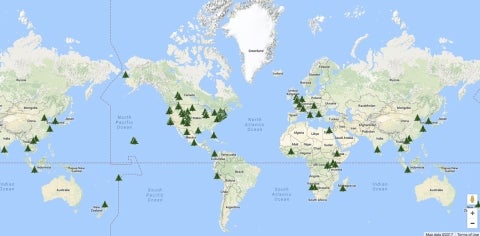Note: Yale School of the Environment (YSE) was formerly known as the Yale School of Forestry & Environmental Studies (F&ES). News articles and events posted prior to July 1, 2020 refer to the School's name at that time.
 <a href="https://mapalist.com/map/630799">View the interactive map</a>.
<a href="https://mapalist.com/map/630799">View the interactive map</a>.
The 151 master’s students completing their first year at the Yale School of Forestry & Environmental Studies (F&ES) will scatter across the world over the next couple of weeks for summer internships and independent research.
The students, who must complete a summer internship or research project in order to meet F&ES graduation requirements, will work in the high plains of Wyoming and in the forests of Madagascar, will monitor corporate sustainability in the California Bay Area and tackle food challenges in Namibia.
The geographic reach and range of projects reflects the multidisciplinary scope of the School itself.
“Our students are all over the world, making a global impact,” said Alyssa Student, assistant director of the F&ES Office of Career and Professional Development.
Thirty-two percent of students will be traveling abroad, including 11 who will spend their summers in Africa. Those working in the U.S. will be scattered across 25 different states, including nearly a dozen in the Rocky Mountain West.
Seventeen percent will conduct independent research, including projects examining energy access in Kenya, community-based forestry in Chihuahua, Mexico, and “moral ecologies” at the Bears Ear National Monument, a federal monument in Utah emerging as a hotspot in the national debate over public lands.
Travel plans are illustrated in an interactive map produced by the Office of Career and Professional Development. The map, which can be viewed here, is a useful resource for documenting student interests and future research opportunities, said Ladd Flock, director of the CPD.
The students, who must complete a summer internship or research project in order to meet F&ES graduation requirements, will work in the high plains of Wyoming and in the forests of Madagascar, will monitor corporate sustainability in the California Bay Area and tackle food challenges in Namibia.
The geographic reach and range of projects reflects the multidisciplinary scope of the School itself.
“Our students are all over the world, making a global impact,” said Alyssa Student, assistant director of the F&ES Office of Career and Professional Development.
Thirty-two percent of students will be traveling abroad, including 11 who will spend their summers in Africa. Those working in the U.S. will be scattered across 25 different states, including nearly a dozen in the Rocky Mountain West.
Seventeen percent will conduct independent research, including projects examining energy access in Kenya, community-based forestry in Chihuahua, Mexico, and “moral ecologies” at the Bears Ear National Monument, a federal monument in Utah emerging as a hotspot in the national debate over public lands.
Travel plans are illustrated in an interactive map produced by the Office of Career and Professional Development. The map, which can be viewed here, is a useful resource for documenting student interests and future research opportunities, said Ladd Flock, director of the CPD.
Published
May 17, 2017